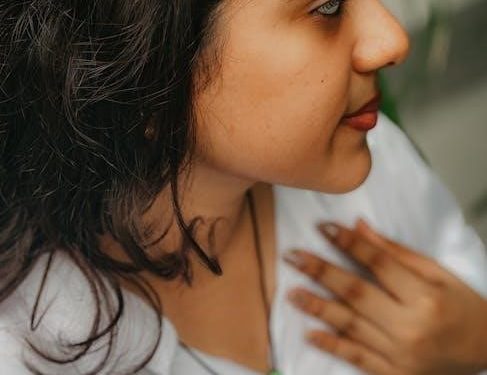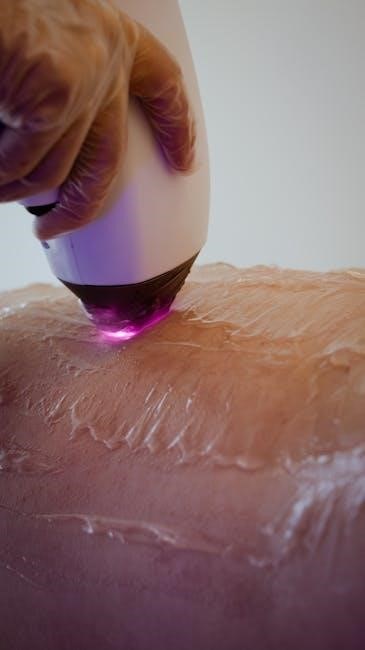
IPL Hair Removal is a non-invasive, long-term hair reduction method using intense pulsed light to target hair follicles. It’s popular for its effectiveness and convenience, suitable for both at-home and professional use.
What is IPL Hair Removal and How Does it Work?
IPL (Intense Pulsed Light) hair removal is a non-invasive cosmetic treatment that uses high-intensity pulses of light to target and damage hair follicles, reducing hair growth over time. Unlike laser therapy, IPL emits a broad spectrum of light, making it suitable for a wider range of skin tones and hair types. During the process, the IPL device emits light that is absorbed by the pigment (melanin) in the hair follicle. This light energy is converted into heat, which damages the follicle and inhibits future hair growth. While IPL is not permanent, it significantly reduces hair regrowth, requiring multiple sessions for optimal results. It is most effective on darker, coarser hairs, as they contain more melanin, making them more responsive to the light treatment.

Preparation for IPL Hair Removal
Preparation involves reading the manual, checking skin and hair suitability, conducting a patch test, and ensuring skin is clean and shaved for optimal IPL results.
Understanding Skin and Hair Requirements
For effective IPL hair removal, it’s crucial to assess your skin tone and hair color. IPL works best on fair to medium skin tones with dark hair, as the contrast allows the light to target the follicle accurately. Avoid using the device on tanned or darker skin, as it may cause burns or uneven results. Hair should be trimmed or shaved to skin level to ensure the light targets the root. Avoid waxing or plucking at least two weeks before treatment, as the hair follicle must be intact for the IPL to work effectively. Always check your device’s guidelines to confirm compatibility with your skin and hair type for safe and successful sessions.
Conducting a Patch Test Before Full Treatment
A patch test is essential before starting full IPL hair removal treatment to ensure safety and effectiveness. Choose a small, discreet area, such as behind the ear or on the ankle, to test the device. Follow the device’s instructions for settings and application. Observe the area for 24-48 hours to check for any adverse reactions, such as redness, irritation, or burns. If no issues occur, proceed with the full treatment. This step helps confirm your skin’s compatibility with the device and prevents potential harm. For devices like the JOVS Venus Pro II or Keskine IPL Handset, always start with the lowest setting during the patch test and adjust as needed based on results.

During the IPL Hair Removal Treatment
During IPL hair removal, shave or trim hair to skin level beforehand. Use the IPL device with appropriate mode and settings for different areas. Ensure full contact with skin for effective treatment.
Step-by-Step Instructions for Using an IPL Device
To use an IPL device, start by shaving or trimming the target area to skin level. Choose the appropriate mode and settings for the specific body part. Place the device flat against the skin, ensuring full contact. Activate the IPL by pressing the pulse button. For larger areas, use glide mode by holding the button down and moving the device smoothly. Avoid overlapping pulses to prevent discomfort. After each session, clean the device and store it properly. Follow the manufacturer’s guidelines for treatment frequency and intensity adjustments. Always refer to the manual for specific instructions tailored to your device.
Understanding IPL Modes and Settings for Different Areas
IPL devices offer various modes and settings tailored for different body areas. For sensitive zones like the face or bikini line, use lower intensity settings to minimize discomfort. Larger areas, such as legs or arms, benefit from higher settings for efficiency. Glide mode is ideal for quick coverage of big areas, while single-pulse mode suits smaller, precise treatments. Adjusting the energy level based on skin tone and hair thickness ensures optimal results. Always consult the device’s manual to select the correct mode and setting for each area to achieve safe and effective hair reduction. Proper customization enhances outcomes and reduces the risk of side effects.

After IPL Hair Removal
Post-treatment care involves soothing the skin, avoiding sun exposure, and refraining from waxing or plucking. Moisturizing and gentle cleansing promote healing and prevent irritation.
Post-Treatment Skin Care and Maintenance
After IPL hair removal, proper skin care is essential to ensure optimal results and minimize side effects. Start by gently cleansing the treated area with a mild, fragrance-free cleanser to prevent irritation. Avoid using harsh exfoliants or abrasive products for at least 24-48 hours post-treatment. Moisturizing is key; apply a soothing, non-comedogenic lotion to hydrate and calm the skin. Direct sun exposure should be avoided for at least two weeks, and when going outside, use a broad-spectrum sunscreen with SPF 30 or higher to protect the skin from UV damage. Additionally, refrain from waxing, tweezing, or using depilatory creams, as these can irritate the skin and interfere with the IPL process. For best results, maintain a consistent skincare routine and follow any specific aftercare instructions provided by your IPL device manufacturer or professional technician.
Managing Potential Side Effects and Aftercare
While IPL hair removal is generally safe, some individuals may experience mild side effects such as redness, irritation, or temporary dryness at the treatment site. To manage these, apply a cooling gel or aloe vera to soothe the skin. Avoid tight clothing to reduce friction and irritation. If redness persists, consider using a gentle, fragrance-free moisturizer to help calm the area. In rare cases, more serious side effects like burns or blisters may occur, often due to improper use of the IPL device. If this happens, stop treatment immediately and consult a healthcare professional. Proper aftercare also involves avoiding hot showers, saunas, or swimming for 24-48 hours to prevent bacterial infections. By following these steps, you can minimize discomfort and ensure a smooth recovery after IPL sessions.

Maintenance and Long-Term Care
Regular maintenance sessions are essential for sustained hair reduction. Most users require touch-ups every 4-6 weeks to target regrowth and maintain smooth results effectively over time.
Tips for Long-Term Hair Reduction and Upkeep
Consistency is key for long-term hair reduction. Regular IPL sessions, typically every 4-6 weeks, help maintain results by targeting regrowth effectively. Exfoliate skin gently to prevent dead hair buildup and promote smoother sessions. Avoid waxing or plucking between treatments, as this can disrupt the hair follicle and reduce IPL effectiveness. Use sunscreen to protect treated areas from sun damage, which can interfere with results. Stay hydrated and maintain a healthy lifestyle to support skin health. Consider touch-ups as needed, especially in areas with denser hair growth, to ensure optimal long-term hair reduction. By following these tips, users can achieve and maintain smooth, hair-free skin with ease.
When to Perform Follow-Up IPL Sessions
Follow-up IPL sessions are essential for maintaining long-term hair reduction. Typically, treatments are spaced 4-6 weeks apart to target hair in different growth phases. For areas with thicker hair, such as the bikini line or underarms, more frequent sessions (every 4 weeks) may be needed. areas with finer hair, like the legs or arms, can be treated every 6-8 weeks. Over time, as hair becomes finer and sparser, sessions can be reduced to every 8-12 weeks. For optimal results, annual touch-ups are recommended to address any regrowth. Consistency is key, as IPL works best when targeting hair in the active growth phase. Adjust the frequency based on individual hair regrowth patterns to achieve the best outcomes. Regular follow-ups ensure smooth, hair-free skin over the long term.